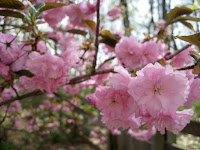 |
| Ed Bruske teaches at Go Local Fair |
I talked last Summer and Fall about our storage of peaches, some 60 lbs of them, cherries and blueberries, 40 lbs of each, and 70 lbs of apples. From the start, I was concerned about two things: first, being caught in the squirrel mentality - store, store, store and if you eat it, you don't have it -- and second, whether we'd be able to finish that ridiculous amount of fruit along with a more manageable amount of veggies we'd frozen. We weren't really dessert people, so we did have to change up our normal eating routines. My nine-year-old son was quite okay with that. I made a lot of pies and crisps, basically aiming for once a week. We had made a ton of preserves with the cherries and blueberries, and we used them almost daily for our plain (homemade) yogurt. Drum roll, please.... we're almost done. The pie was the last of the apples, the peaches are gone, the preserves, except one jar, are gone. We have a few large bags of cherries and blueberries, but we are quickly turning them into smoothies using the whey from our cheese. (adding that protein removes them from the dessert pile into the oh-so-good-for-you-pile, eat them when you want pile). and we have one pint of apple sauce left. So, wow, now I know how much fruit we can consume. Strawberries are already starting to come around.
 |
| The peach freeze |
The Go Local Fair put on by Sustainable Living Maryland yesterday in Westminster was another turning point. We got to see all the farming faces that we missed over the Winter months and catch up on their plans. Ed Bruske, the Slow Cook, from Washington, D.C., did a cooking with kids talk, which was fabulous. He did a small version of what he teaches in an aftercare program in D.C., and the kids made zucchini carppaccio, asparagus salad with a mustard vinaigrette, and strawberry crepes. In this courses, he teaches the kids about international foods, sustainability, and how to really cook. His daughter accompanied him and was a great help to the class; at ten years old, you can see how confident she is in the kitchen. He also teaches the kids about consuming all parts of the animal and discussed recently bringing in chicken livers for them to cook. It was a small audience, but hopefully others enjoyed it as we did. I highly recommend his blog as an insight into the things he does with the kids and with school food reform.
 |
| Truffula Produce's Lettuce Dryer |
I also ran into Dave Baldwin of Furnace Hills Coffee. The brick-n-mortar business is coming! He expects it to open this week or next. Once I get a chance to go visit it on Main Street, Westminster, I'll post some photos and details. His coffee is so reasonably priced and so developed with a heart, I highly recommend it.
Scott from Sattva Place Farm was there too. He will be processing 100 chickens soon, and his plan is to have fresh chicken available at the Westminster Market every weekend this season. Scott is certified organic and a one man farm. Our buying group has been nothing but happy.
 |
| Akeys CSA pick up last year |
I took a quick peek into De La Tierra's tent and didn't get time to chat with owner, Jackie, but I know she will be selling cut flowers at the market and she is selling her beautiful plants this Spring for the garden, both flowers and produce. I also ran into Greg Thorne, of Thorne Family farms, and he said that because of the constant rain we've had over many weeks now, their planting is way behind. He left the fair early to take advantage of the good weather and get some work done on the land.
This past Winter, we were able to make it through using our winter CSA from Everblossom Farm and our food storage, with almost zero produce bought at the grocery store. I never would have thought we could do that, and eat a ton of veggies. We did. What a great local challenge for ourselves. Now, we are looking forward to the season of plentiful.
This post is going to be part of the Hearth and Soul blog hop this week... make sure to check out all the other entries for some great and fascinating food-related articles!
 | |
| Emus at the Fair |

